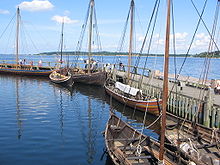Viking Ship Museum Roskilde
 Museum halls, the older part of the museum. |
|
| Data | |
|---|---|
| place | Vindeboder 12, 4000 Roskilde, Denmark |
| Art |
Museum of cultural history
|
| architect | Erik Christian Sørensen (museum halls) |
| opening | Founded in 1962, 1969 opening of the museum hall, 1997 opening of the Museum Island |
| management |
Tinna Damgård-Sørensen
|
| Website | |
The Viking Ship Museum (Danish: Vikingeskibsmuseet) in Roskilde is a Danish museum for prehistoric and medieval ships, seafaring and shipbuilding.
history
In 1962 five Viking ships were excavated at Skuldelev in the Roskilde Fjord . These ships, dated around 1070 AD, were sunk to protect and control the main ferry of the fjord from enemy attacks. After that, Roskilde itself could only be reached via a deep, meandering side fairway, which required a good knowledge of the area. In the case of an attack by sea, this would give an attacker a lot of time and v. a. tasted the element of surprise.
Roskilde , located at the end of a flat, narrow and long fjord, was at that time the center of Danish power in the Baltic Sea region with corresponding wealth.
The barrier was created at the "Peberrende" near Skuldelev, approx. 20 km north of Roskilde. For this purpose, five Viking ships of different designs were loaded with field stones and then sunk on site in a specific arrangement across the fairway. As a result, they formed an invisible and insurmountable barrier for ships. In the period that followed, the underwater obstacle was stabilized and cared for by adding stone weights.
With the end of the Viking Age and the rise of Copenhagen , Roskilde gradually lost its importance as the headquarters of Danish kings and the barrier was forgotten. The five recovered ships represent a typology of Viking ships and are the main exhibits of the museum.
Find
In the Roskilde Fjord, fragments of old ships (parts of planks, etc.) have repeatedly been washed ashore or found in nets by fishermen. Investigations showed that these fragments must have been around 900 years old, which archaeologists called for. Large artifacts were discovered near Skuldelev in the early 1960s as part of sonar soil surveys of the fairways. Divers, in turn, found other fragments that matched the earlier finds. Recognizing the uniqueness and significance of the finds, temporary sheet piling was driven in around the site in 1962 due to the sheer size of the finds and the site was drained so that excavations and salvage could begin.
In order to better understand the dimensions of the underwater obstacle, please refer to the size of the recovered wrecks:
- Skuldelev 1: Large merchant ship, 16 m × 4.8 m. Cargo capacity 20–24 tons. Degree of conservation 60%. Sailed to Iceland, Greenland and North America. Replica: " Ottar ".
- Skuldelev 2: longship / warship, 30 m × 3.8 m. 80 warriors, 30 pairs of straps. Degree of conservation 25%. Replica : " Glendalough Sea Stallion ".
- Skuldelev 3: Small merchant ship, 14 m × 3.3 m. Cargo capacity 5 tons. Degree of conservation 75%. Sailed in the Baltic region. Replica: "Roar Ege".
- Skuldelev 4: Small longship / warship, 17.3 mx 2.5 m. 30 warriors, 13 pairs of straps. Degree of conservation 50%. Replica: "Helge Ask"
- Skuldelev 5: Small cargo ship / ferry / fishing / hunting, 11.2 mx 2.5 m. Freight capacity 4.5 tons. Degree of conservation 70%. Replica: "Kraka Fyr".
The Viking Ship Museum, built in 1969 specifically for the five recovered ships, is located directly on the Roskilde Fjord. During excavations for an extension in 1996-97, nine more ships were discovered, including the Roskilde 6 , the largest longship discovered to date from the Viking Age. A total of around 1500 large pieces of wreckage and countless fragments were recovered. The total number should have been around 50,000. In order to maintain this, they were first kept moist, then sprayed with a formalin solution , wrapped in plastic film and then stored in polyethylene glycol preservation baths for between six months and two years, depending on their size . The fragments were carefully measured and scanned using a 3D computer program. In the museum, the wreckage was integrated into true-to-original steel skeletons to let the size of the ships affect the visitors. The hulls, placed in front of the huge panorama windows with a view of the fjord, make the ships practically "swim".
From the data obtained, models were also calculated, which were first built on a reduced scale for trial purposes, and then scanned again and improved. Various replicas were then made based on these models to demonstrate their seaworthiness.
The largest replica is the 30 m long " Sea Stallion of Glendalough ". The ship was built using traditional tools and techniques from the Viking Age, and made its furthest voyage in 2007 to Dublin , Ireland - where the original ship was once built around 1042.
Ole Crumlin-Pedersen was the founder and first director of the museum until 1985 .
Furnishing
In addition to the actual museum hall, which has an area for special exhibitions, a workshop in which reconstructions of Viking ships are made, as well as a large number of replicas of the Skuldelev ships in its own port belong to the museum's area.
Web links
panorama
Coordinates: 55 ° 39 ′ 0.5 ″ N , 12 ° 4 ′ 44 ″ E
Individual evidence
- ^ "Wikinger Waräger Normannen" exhibition catalog, 1992 ISBN 87 7303 559 9 , page 42
- ↑ Archived copy ( memento of the original from November 29, 2014 in the Internet Archive ) Info: The archive link was inserted automatically and has not yet been checked. Please check the original and archive link according to the instructions and then remove this notice.



